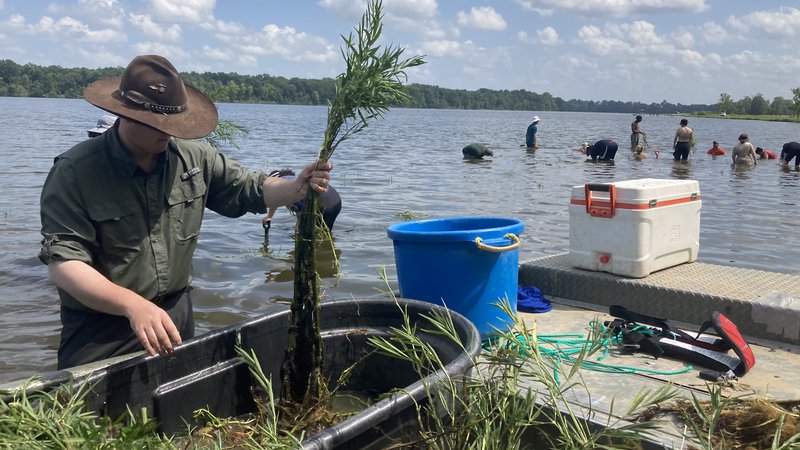PINE BLUFF — The Arkansas Game and Fish Commission, in cooperation with the American Fisheries Society, led 30 prospective future fisheries biologists in establishing more than 300 yards of aquatic habitat in the Arkansas River in July.
The project, coordinated by Jamie Kindschuh, Arkansas River/commercial fishing Biologist for the AGFC, was part of the agency’s partnership with the American Fisheries Society’s Hutton Junior Fisheries Biology Program. This program offers internships and scholarships to high school students pursuing careers in fisheries management to help them begin their college experience with valuable insight into real-world applications of the science they will be learning.
Top photo: AGFC biologists oversaw 30 high school students as they planted aquatic grass for the future of Arkansas fishing.

By Randy Zellers
Arkansas Game and Fish Commission

High school students from around the country were part of the effort. They were based at the University of Arkansas at Pine Bluff in mid-July attending the third annual Hutton Scholars Summit, the first time the three-day conference has been held in the state. They spent the day planting water willow, a beneficial native aquatic plant that was transferred from other portions of the river. Although water willow is found throughout the Arkansas River system in The Natural State, high water or strong currents can wash it out of some areas, leaving a void in habitat.
“Electrofishing catches in this area consisted of low numbers of game and nongame fish,” Kris Nault, fisheries supervisor in the AGFC’s Monticello Regional Office, said. “The water willow planted in this area will produce excellent cover for both juvenile and adult game fish and should help increase survival of juvenile largemouth bass.”

Seven AGFC employees worked alongside the students to plant seven large tubs of the vegetation in Pine Bluff Harbor. The water willow was planted in three different areas of a sand flat at Regional Park in 1-3 feet of water.
“The water willow should expand over time to fill in gaps where it was not planted and continue to grow and offer cover for game fish and forage species,” Nault said.
The Hutton Junior Fisheries Biology Program was established in memory of Robert F. Hutton, who served as the first executive director of the AFS. Seventy-two percent of Hutton Scholar alumni in the past decade attribute their internship to increasing their interest in fisheries, aquatics or environmental science studies and careers. Also, 69 percent of alumni in the same period are currently studying or have studied fisheries or other biological sciences since their internship.


